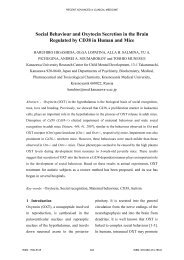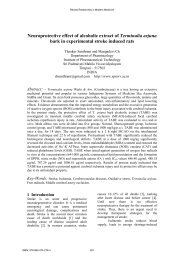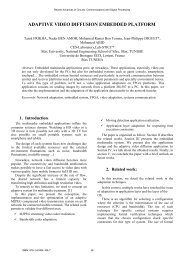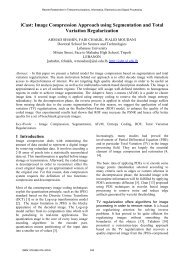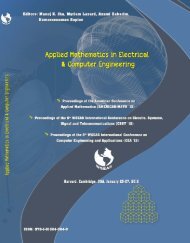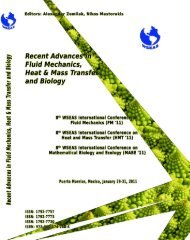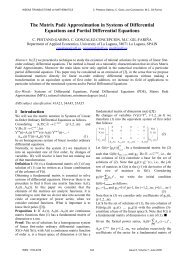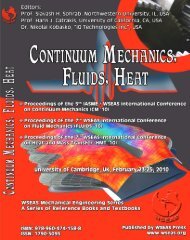Exergetic analyses applied in Pilot Plant for Tritium and ... - Wseas.us
Exergetic analyses applied in Pilot Plant for Tritium and ... - Wseas.us
Exergetic analyses applied in Pilot Plant for Tritium and ... - Wseas.us
Create successful ePaper yourself
Turn your PDF publications into a flip-book with our unique Google optimized e-Paper software.
Proceed<strong>in</strong>gs of the 2nd International Conference on Environmental <strong>and</strong> Geological Science <strong>and</strong> Eng<strong>in</strong>eer<strong>in</strong>g<strong>Exergetic</strong> <strong>analyses</strong> <strong>applied</strong> <strong>in</strong> <strong>Pilot</strong> <strong>Plant</strong> <strong>for</strong> <strong>Tritium</strong> <strong>and</strong>Deuterium SeparationSORIN GHERGHINESCUDepartment : 1 National Institute of R&D <strong>for</strong> Cryogenics <strong>and</strong> IsotopesTechnologies (ICIT)Adress : code 240050 - Rm. Valcea, Uz<strong>in</strong>ei 4, CP10, Valcea, ROMANIA,phone:0040 250 736979, fax:0040 250 732746,COUNTRY : Romaniae-mail: sor<strong>in</strong>@icsi.ro sor<strong>in</strong>70g@yahoo.comT http://www.icsi.roAbstract : In the nuclear reactors <strong>us</strong><strong>in</strong>g uranium as fuel <strong>and</strong> heavy water asmoderator, after a while, due to <strong>in</strong>creased tritium concentration as result of neutronscapture on deuterium nucle<strong>us</strong>, we have to establish a set of measures to decrease thetritium concentration.The amount of tritium obta<strong>in</strong>ed <strong>in</strong> a CANDU reactor is about 2,4 KCi/MW.The experimental plant realise the separation <strong>and</strong> extraction of tritium from tritiatedheavy water at 30 Ci/kg (<strong>for</strong> a higher concentration will be diluted at that level).The tritium request <strong>in</strong> the USA was 4*10 6 Ci <strong>in</strong> 1980; <strong>in</strong> Romania was 2*10 4 Ci <strong>in</strong>1990, 3*10 4 <strong>in</strong> 2000 <strong>and</strong> will cont<strong>in</strong>ue to <strong>in</strong>crease. On present times the price <strong>for</strong>tritium is estimated at about 2$/Ci [1] on <strong>in</strong>ternational market <strong>and</strong> <strong>in</strong>creas<strong>in</strong>g. This isdue to grow<strong>in</strong>g <strong>and</strong> cont<strong>in</strong>ues diversification of application fields; nuclear medic<strong>in</strong>e,nuclear f<strong>us</strong>ion, research labs.The experimental <strong>Pilot</strong> plant <strong>for</strong> tritium <strong>and</strong> deuterium separation, part ofNational Research <strong>and</strong> Development Institute <strong>for</strong> Cryogenics <strong>and</strong> Isotopic Technologies- ICSI Rm.Valcea, as pr<strong>in</strong>cipal target have to establish the technology of the waterhydrogencatalyzed isotopic exchange <strong>and</strong> cryogenic distillation <strong>for</strong> mixtures ofhydrogen <strong>and</strong> his isotopes diatomic species.The ma<strong>in</strong> target of the experimental pilot plant is to establish the detritiationtechnology of CANDU reactor moderator <strong>and</strong> to certify the equipments specific <strong>for</strong>cryogenic doma<strong>in</strong> <strong>and</strong> tritiated mediums.The most important part of the experimental <strong>Pilot</strong> plant <strong>for</strong> tritium <strong>and</strong>deuterium separation is module 300(cryogenic distillation of hydrogen/deuterium/tritiummixture). The pr<strong>in</strong>cipal goals on to that module are:a) to <strong>in</strong>sure <strong>and</strong> ma<strong>in</strong>ta<strong>in</strong> the proper temperature <strong>for</strong> hydrogen condensation <strong>in</strong>the head of the distillation column,b) to elaborate the high efficiency contact elements on hydrogen isotopesseparation.There<strong>for</strong>e, to accomplish the task presented at the po<strong>in</strong>ta) , the hydrogendistillation column condenser is cooled with<strong>in</strong> a hydrogen cryogenic cycle which is<strong>in</strong>sur<strong>in</strong>g a level of temperature with<strong>in</strong> 20-30 K, correspond<strong>in</strong>g to the work<strong>in</strong>g pressureof the distillation column.Also, it has to be mentioned the special character both <strong>for</strong> dynamic <strong>and</strong> staticequipment as <strong>for</strong> entire measurement <strong>and</strong> control systems with are parts oftechnological outflow work<strong>in</strong>g under liquid nitrogen temperature.The tasks of experimental techniques effectuate with<strong>in</strong> experimental <strong>Pilot</strong> plant<strong>for</strong> tritium <strong>and</strong> deuterium separations <strong>in</strong>to module 300 are:ISSN: 1790-2769 242 ISBN: 978-960-474-119-9
Proceed<strong>in</strong>gs of the 2nd International Conference on Environmental <strong>and</strong> Geological Science <strong>and</strong> Eng<strong>in</strong>eer<strong>in</strong>g‣ establish<strong>in</strong>g the work<strong>in</strong>g parameters <strong>in</strong> different states of nitrogen cryogeniccycle.‣ function<strong>in</strong>g checkout <strong>for</strong> dynamic <strong>and</strong> static equipments (turboexp<strong>and</strong>ers,compressors, etc.) control <strong>and</strong> measurement equipments specifically <strong>for</strong>cryogenics liquids operations.‣ overlook<strong>in</strong>g the materials comportment at cryogenic temperatures booth <strong>in</strong>steady state <strong>and</strong> <strong>in</strong> transition states.Key-Words: exergetic <strong>analyses</strong>, cryogenic cycles, distillation column.1. IntroductionHydrogen is a carefully manipulat<strong>in</strong>gsubstance, <strong>in</strong> respect with the laborsafety rules, due to its flammablecharacter <strong>for</strong> large concentration<strong>in</strong>terval (4-75%). It also has anexplosion risk <strong>for</strong> a concentrationbetween 18 <strong>and</strong> 65%, especially <strong>in</strong>closed areas. Special care has to begiven to avoid the presence of solidoxygen <strong>in</strong>to the liquid hydrogen.Hydrogen sources have <strong>in</strong>d<strong>us</strong>trialcharacter <strong>and</strong> basically consist <strong>in</strong> thefollow<strong>in</strong>g technological processes:catalytic steam re<strong>for</strong>m<strong>in</strong>g of naturalgas, partial oxidation of comb<strong>us</strong>tiblehydrocarbons, electrolysis of water,dissociation of hydrogen molecular ionswith<strong>in</strong> the pale of 0,4 – 1.10 -4 mol.%Three isotopes of hydrogen are known.The most abundant is protium (a s<strong>in</strong>gleproton) followed by deuterium (aproton <strong>and</strong> a neutron) <strong>and</strong> the leastabundant tritium (a proton <strong>and</strong> twoneutrons), the third isotope which isvery rare <strong>and</strong> radioactive (beta_rayemitter with an energy level at 5.6keV<strong>and</strong> 12.3 years half-life).Hydrogen isotopes separation is basedon the very small differences betweenthe physical characteristics, as shown <strong>in</strong>table 2, which will characterize thedevelopment of the separationtechnologies by a large specific volume<strong>and</strong> a high sensitivity <strong>in</strong>to theemployment of plant.The specifically behavior of hydrogenis due to different arrangements of theparticle sp<strong>in</strong> which constitute thehydrogen molecule.If the particle sp<strong>in</strong>s alignment isparallel we speak about ortohydrogen(o-H 2 ) <strong>and</strong> if particle sp<strong>in</strong>s alignmentis opposite (the nuclei are sp<strong>in</strong>n<strong>in</strong>g <strong>in</strong>opposite directions) we haveparahydrogen (p-H 2 ).Table 2H 2 HDD 2DT T 2T K33,24 35,9 38,2 39,5 40,6KPk12,797 14,6 16, 17,3 18,1kg/cm 2 2V k66,95 _ 60, - 57,1m 3 /mol33 4 5Molecular mass 2(2,016)6g/molBoil<strong>in</strong>gtemperatureat 1atm20,39 22,13 23,57- -At the ill<strong>us</strong>tration 1 we can see howthese molecules look like.Figure 1On table 3 we present the pr<strong>in</strong>cipalcharacteristics of the two molecularspecies, orto- <strong>and</strong> para-hydrogen:Table 3Critical po<strong>in</strong>tBoil<strong>in</strong>gpo<strong>in</strong>t at 1atmOrtho-hydrogenP 12,98 12,759Para-hydrogenT 33,18 32,976ρ 0,01494 0,01559T 20,38 20,2680,0352 0,03511ρ L0,0006606 0,0006636ρ VISSN: 1790-2769 243 ISBN: 978-960-474-119-9
Proceed<strong>in</strong>gs of the 2nd International Conference on Environmental <strong>and</strong> Geological Science <strong>and</strong> Eng<strong>in</strong>eer<strong>in</strong>gTriple po<strong>in</strong>tp->S ->solidP 0,071 0,0695T 13,947 13,803ρS3,04301 0,04291ρL0,03830 0,03821ρV0,0000631 0,0000624atmT -> K2. Operation mode <strong>and</strong> heat transfercalculationCryogenic cycle of hydrogenTTAt ord<strong>in</strong>ary temperatures, hydrogen is amixture of 75% ortohydrogen <strong>and</strong> 25%parahydrogen, known as normalhydrogen.The equilibrium percentage of orto<strong>and</strong>parahydrogen varies withtemperature as shown <strong>in</strong> the diagram 2Table 4T(K) 15 20,39 30 50 60 70q(J/s) 527 525 506 364 285 216PPFSRSRTL2.1 Theoretical model <strong>for</strong> thecalculation of the non-reversible lossesof detention <strong>and</strong> astrictionTP1TT 2T 22S2TPC303TPTdetentionSFigure 1As the temperature is brought down,the share of parahydrogen <strong>in</strong>creases,reach<strong>in</strong>g 99.8% at equilibrium; this isknown as orto-para conversion, whichtakes place spontaneo<strong>us</strong>ly <strong>in</strong> the liquidphase, but very slowly. For example,liquefied normal hydrogen at first hasthe composition of the orig<strong>in</strong>al gaseo<strong>us</strong>hydrogen. With time, however, thefraction of parahydrogen, (x p-H2 ),<strong>in</strong>creases:LossesLosses1−k⎡ ⎛⎞⎤p k1p1c T⎢ ⎜ ⎛ ⎞ ⎟⎥⎛ ⎞⋅p⎜2p⎟⎢ ⎜ −⎜⎟ ⎟⎥⎝ 2⎢ ⎜ ⎝ ⎠ ⎟⎥⎠⎣ ⎝⎠⎦k −1⎡ ⎛⎞⎤p k⎢ ⎜ ⎛⎟2⎞ ⎥⎢ ⎜1−⎜p⎟ − 1⎟⎥⎛ p ⎞cpT ⎢ ⎜ ⎝ 1 ⎠ ⎟ 2= ⋅⎥ ⋅⎜astrp⎟0⋅ ln 1 +⎢ ⎜ η ⎟⎥⎝ 1 ⎠⎢ ⎜⎟⎥⎢ ⎜⎟⎥⎣ ⎝ P ⎠⎦ir_det=p⋅0⋅ ln 1 − ηdet1ir_astrTTTT212Pk −1k1−kkxp − H 20.25 + 0.00855 ⋅ τ≅1 + 0.00855 ⋅ τWhere τ is the time <strong>in</strong> hours. Forexample, <strong>in</strong> 100 h, x p-H2 will be 0.595,<strong>and</strong> <strong>in</strong> 1000 h it will be about 0.92.astrictionThe efficiency(η ) of process :SISSN: 1790-2769 244 ISBN: 978-960-474-119-9
Proceed<strong>in</strong>gs of the 2nd International Conference on Environmental <strong>and</strong> Geological Science <strong>and</strong> Eng<strong>in</strong>eer<strong>in</strong>gηηdetastr==h1h1h2sh2−−h2h−−2sh1h1dE2= & m2⋅ [( h2'− h2''− T0⋅ ( s2' '− s2')]with hydrogendE2ηE _ ∆T=dE12.2 Model of calculation the nonreversiblelosses trough trottl<strong>in</strong>gLossesir _ ∆ T=dE1− dE2dE1, dE 2- exergy of the heatexchanged between the two fluidsm&1- flow rate of hot fluid (1)m& - flow rate of cool fluid (2)2Lossesir_trottle= T0⋅ ( s4− s3)2.3 Model of calculation the nonreversiblelosses trough heat transfer1E 2’’dQEE E 1’3.1 Results of exergetic <strong>analyses</strong> of thecycle:2Losses (%)ir_trottleLosses (%)ir_astrLossesir(%)_ ∆TLosses (%)ir_extηex41 30 15 5 9E − E=E− E1 ` 1`` 2``1= E1`− E1``2= E2``− E2`dEdE2`+ Losses ir_ ∆T3. Experimental data <strong>for</strong>cryogenic cycleTE321(K)TE322(K)TE325(K)TE326(K)TE330(K)FR306(Nm 3 /h)PR316(bar)PR323(bar)TIME(h)FR306(kmol/h)265 235,7 168,1 164,5 223 29,7 0,32 34 2 1,323977679226 213,6 133,6 128,8 183,3 29,7 0,24 32 3 1,323977679194,9 199,3 115,4 114,7 166,3 31,5 0,4 32 4 1,40421875171,7 189,9 104,6 103,1 154,3 33,3 0,4 36 5 1,484459821154,7 162,5 98,5 93,8 137 37,8 0,24 50 6 1,6850625135,5 140,2 91,4 84,1 120,5 43,2 0,32 61 7 1,925785714119,6 129 87,8 79 113,2 46,8 0,36 66 8 2,086267857114,8 120,8 81,6 71 113,1 48,6 0,48 68 9 2,166508929dE[( h − h − T ⋅ s − )]1m1⋅1' 1' ' 0(1's1''= &ISSN: 1790-2769 245 ISBN: 978-960-474-119-9
Proceed<strong>in</strong>gs of the 2nd International Conference on Environmental <strong>and</strong> Geological Science <strong>and</strong> Eng<strong>in</strong>eer<strong>in</strong>g4. Concl<strong>us</strong>ionsIt is seen that the heat evolved dur<strong>in</strong>gconversion <strong>in</strong> liquefied normalhydrogen exceeds the heat ofevaporation (447 J g -1 ). Beca<strong>us</strong>e ofthis, even <strong>in</strong> an ideal <strong>in</strong>sulated vessel,normal liquid hydrogen can boil off <strong>in</strong>the course of an ortho-para conversion.There<strong>for</strong>e, it is <strong>us</strong>ual dur<strong>in</strong>gliquefaction to subject the hydrogen toan accelerated conversion <strong>in</strong> thepresence of solid catalysts eachdisposed <strong>in</strong> colder areas, start<strong>in</strong>g with65-75K until 20K.[1]SCIENCE, Volume 274, Number5290, Issue of 15 November 1996Bibliography1. Ullmanns Encyklopedie dertechnischen Chemie, Vol.3.EdituraChemie,We<strong>in</strong>heim, 1973.2. A.Arkharov, I.Marfen<strong>in</strong>a, Ye.Mikul<strong>in</strong>: Theory <strong>and</strong> Designof Cryogenic Systems. EdituraMir, Moscova, 1981.3. R.A.Haefer Kryo-Vakuumtechnik. Grundlagenund Anwendungen. EdituraSpr<strong>in</strong>ger, Berl<strong>in</strong>, 1981.4. M. Peculea : InstalatiiCriogenice , Editura ConphisRm. ValceaISSN: 1790-2769 246 ISBN: 978-960-474-119-9




